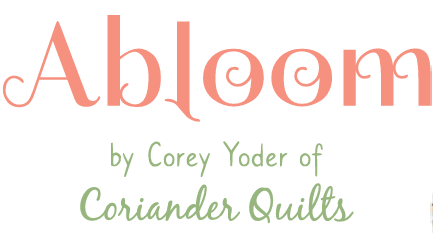Scrappy Faux Piped Binding Tutorial
On Friday, I shared a little sneak peek over on facebook of what I had been working on . And today, I’m excited to bring to you a binding tutorial that I’m pretty excited about.
You all know that I was finishing up the binding on Elonie’s quilt and had pretty much decided to do a scrappy binding after getting all of your opinions. But, it stuck in my head that several of you had mentioned that you felt a scrappy binding usually detracts from the quilt itself.
After mulling this over a bit, I decided to try a scrappy faux piped binding done completely by machine. Now, I have tried machine binding methods before and I have n.e.v.e.r. been happy with the results…pin this, glue that, and after binding only 15.2 quilts you, too, will have great machine bound quilts. I’m picky about my binding, and I want the back to look as good as the front(preferably on the first try–if you click the picture above you can see the back side of my quilt binding in larger detail)–which I have never had success with with machine binding. I found this method to be less finicky than other machine binding I have tried and I was much happier with the results right out of the gate. I’m also excited to have a machine binding technique that I am happy with so I can choose not to hand stitch! So, I’m excited to share this tutorial with you and some tricks I learned along the way.
First off, you’ll cut your binding strips as you normally would with one exception–you will be cutting two sets. Cut the strips for the piping 1 3/4″ x wof(these are the colorful strips) and cut the strips for the main binding 1 1/2″(these are the white strips). Sew all of the piping strips together(I use a mitred seam) & sew all of the white strips together(again, I use a mitred seam). Tip: Cut your strips as accurately as possible. This will help with the accuracy of the piping width and seam along the backside of the quilt when you sew the binding down.
Next, sew the binding strips and the piping strips right sides together using a 1/4″ seam allowance.
Press the seam to one side. I pressed toward the piping fabric to bulk it up a little bit to give it more the look of actual piping. Tip: Be careful when pressing to keep your strips as even as possible–the less ripples the more accurate the final result will be. Next, press the strips wrong sides together–be careful to align the raw edges. You’ll end up with some great piped binding.
The next step is to sew the binding to the back of the quilt using a 1/4″ seam allowance. Complete this step as you normally would when initially sewing binding to a quilt. Somehow, I managed to not take a picture of this step but I think you get the idea. =) After sewing down the binding to the back of the quilt, flip the binding to the front and machine quilt it down.
Initially when I started this step, I carefully pinned the binding into place to insure everything lined up. But, somehow, everything didn’t line up. So, I gave it a whirl with no pinning and I found out that on my Bernina with a walking foot, if I lined up the right side of the foot with the fold and the needle in the ditch of the piping/binding that the seam on the back was perfect. As long as I kept everything lined up the back was fantastic. Now, of course there were times when I veered off a tad but all in all, pretty good!–You can click the 2nd picture from the top to get a larger view of the back to see the stitching(the row with no piping is the back of the quilt). For the corners, I mitred them together as I got to them–this will take a bit more practice to get perfect–the key here is to make sure when you initially sew the binding to the quilt that your corners are neat and tidy.
You should end up with a great alternative binding to hand stitching–and hopefully with less frustration than machine binding can be!
And, here’s Elonie’s finished quilt. I think the scrappy piping is just perfect it doesn’t overwhelm the quilt and it’s not as harsh as a solid might have been or as busy as a print might have been.
Hope you all enjoy the tutorial!






































I have long admired the faux piping on a binding and have used it a lot myself. But never imagined it scrappy. That’s brilliant! Thanks sew much for sharing!
What a clever idea! It sets off your quilt just perfectly, sorta scrappy but without detracting from the design. Just perfect 🙂
It looks very professional, thank you for the tutorial will definitely be trying that method. I’ve pinned you on my home screen so I can find you quickly. Hope your arms don’t start aching with the ‘hanging’ around;)
Thank you for sharing
Peg x
That’s brilliant!! Thank you so much for sharing this method!! Great tutorial!
Corey, this is STELLAR!!!! I am quilting a table runner right now and this is going to be a magnificent touch. I’ll try it out on something smaller first but I am excited to use this faux piping method. Thank you for the VERY clear tutorial!!
~Christina in Cleveland
Oh, I got so excited I forgot to tell you how wonderful Elonie’s quilt is! I love the quilt, quilting AND the binding!
~Christina
Thank you for showing this fabulous way of binding.
Wow – beautiful! Never would have thought of this beforehand, but it is the best binding for this quilt. It just adds a perfect finishing touch!! Love it!
You are amazing! I have been trying to find a machine binding solution myself and I think I’ll give this a try! You know as I know, some quilts need to be done quick and machine binding is okay. Now I need to find a quilt to try this out on!
I love it. Now I have to make a quilt like yours and try it. Thanks for a great tutorial.
Wow! This post is just what I needed right now. I have a quilt I made in all solids and white background during the Moda Friendship hop that I need to bind this week–and this is the way I’m going to do it! This is perfect! Thank you so much for this nicely done tutorial.
Wow, very cool outcome! Thanks for the detailed tutorial!
Oh, I love that binding. Just fantastic. What a perfect finish to a stunning quilt!
Just pinned! Thanks for sharing. I love this quilt!
GREAT AWESOME BEAUTIFUL!!! Love what you did, it is PERFECT!
BRAVO!! Thank you for sharing the wonderful tutorial. You explained everything so clearly. I hope my results will be as good as yours when I try it.
oh this is genius – thanks much for sharing! It looks terrific!
What a fantastic idea. And thanks so much for your detailed instructions. I am going to try this on my next project.
I LOVE this idea so much. Perhaps I am being thick – but I can’t quite figure out how you attach your binding – I tend to sew mine to the front and then flip & hand finish on the back. I think I can still make this idea work for that too.
Perfect choices! This is a technique I need to try.
LOVE IT!!!! 🙂 I’m thinking the little table topper Mom did would look cute done like this!…may pick your brain on what colors to use 🙂
Brilliant. Thanks for sharing. I only machine attach my binding, and I’m pretty good at it, but this will give me some variety when I want it.
Love your quilt and the binding is beautiful…thanks for the tutorial!
Gorgeous!!!
I love this quilt!! The faux binding is great too. I’ve always liked the idea of machine-stitching binding on, but i didn’t like the look on the back of the quilt. The faux piping makes machine-stitching the binding on make sense and look good too! Great tutorial. Thanks.
This is a great tutorial! Just perfect for this quilt.
Never seen binding like this before, I think I just fell in love! I think it is the perfect finishing touch for your quilt and I will definitely try the technique myself. Thanks for the tutorial.
What a wonderful look, I will certainly try this.
Love your quilt,just stunning and sure I`ll try the faux binding.Thanks for the tutoria.Have a fun week!!
This looks great! I think I’ll try this on my version of this quilt when I get it finished! Thanks for an awesome tutorial!
Thank you for this tutorial….I love this binding…I always machine bind, and this will be a great finishing for many projects!